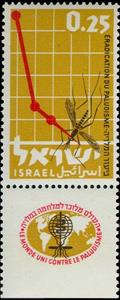Stamp with Collectible Margin: Malaria Eradication (Israel 1962)
Malaria Eradication (Israel 1962)
30 April (Israel ) within release Malaria Eradication goes into circulation Stamp with Collectible Margin Malaria Eradication face value 0.25 Israeli lira
| Stamp with Collectible Margin Malaria Eradication in catalogues | |
|---|---|
| Michel: | Mi: IL 253T |
| Stamp Number: | Sn: IL 218T |
| Yvert et Tellier: | Yt: IL 217T |
| Stanley Gibbons: | Sg: IL 231T |
Stamp with Collectible Margin is square format.
Also in the issue Malaria Eradication:
- Stamp - Malaria Eradication face value 0.25;
- Stamp with Collectible Margin - Malaria Eradication face value 0.25;
Stamp with Collectible Margin Malaria Eradication it reflects the thematic directions:
A diagram is a symbolic representation of information using visualization techniques. Diagrams have been used since prehistoric times on walls of caves, but became more prevalent during the Enlightenment. Sometimes, the technique uses a three-dimensional visualization which is then projected onto a two-dimensional surface. The word graph is sometimes used as a synonym for diagram
Insects (from Latin insectum, a calque of Greek ἔντομον [éntomon], "cut into sections") are a class (Insecta) of hexapod invertebrates within the arthropod phylum that have a chitinous exoskeleton, a three-part body (head, thorax and abdomen), three pairs of jointed legs, compound eyes and one pair of antennae. They are the most diverse group of animals on the planet, including more than a million described species and representing more than half of all known living organisms. The number of extant species is estimated at between six and ten million, and potentially represent over 90% of the differing animal life forms on Earth. Insects may be found in nearly all environments, although only a small number of species reside in the oceans, a habitat dominated by another arthropod group, crustaceans. The life cycles of insects vary but most hatch from eggs. Insect growth is constrained by the inelastic exoskeleton and development involves a series of molts. The immature stages can differ from the adults in structure, habit and habitat, and can include a passive pupal stage in those groups that undergo 4-stage metamorphosis (see holometabolism). Insects that undergo 3-stage metamorphosis lack a pupal stage and adults develop through a series of nymphal stages. The higher level relationship of the Hexapoda is unclear. Fossilized insects of enormous size have been found from the Paleozoic Era, including giant dragonflies with wingspans of 55 to 70 cm (22–28 in). The most diverse insect groups appear to have coevolved with flowerin plants.

